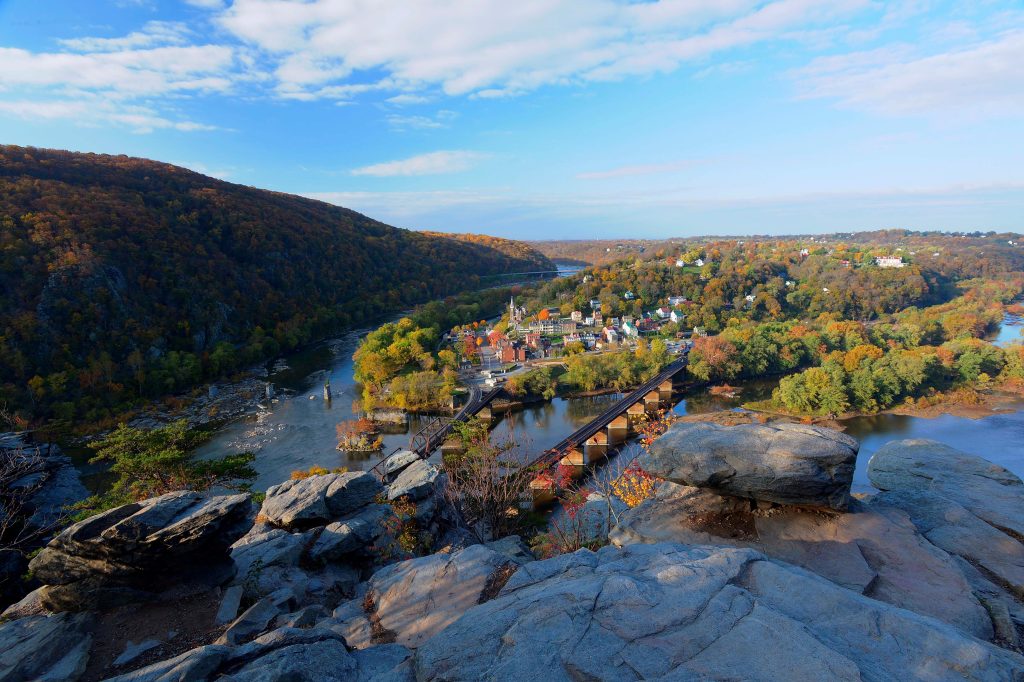A Thousand Words a Battle: Harpers Ferry

In the summer and autumn of 1865, New England author John Townsend Trowbridge traveled throughout the southern states, visiting the principal battlefields and cities of the recent conflict as far off as New Orleans. Trowbridge offers compelling interviews with local residents—white and black, Union and Confederate—and graphic descriptions of the battle-scarred landscape in the months immediately following the close of the war. One of the first stops on his journey was at Harpers Ferry, West Virginia.
Harpers Ferry had witnessed nearly six years of continual conflict, occupation, and destruction, from John Brown’s raid in October 1859 to the destruction of the United States armory, rifle factory, bridges, railroad, and the town’s commercial district. Harpers Ferry changed hands eight times over the course of four years, and the numerous battles and skirmishes claimed the lives of combatants and noncombatants alike. Fortifications and earthworks cut into the heights ringing the lower town forever altered the terrain.
Trowbridge’s description of Harpers Ferry reads like poetry, capturing the stunning visual landscape:
At Harper’s Ferry the Potomac and Shenandoah unite their waters and flow through an enormous gap in the Blue Ridge. The angle of land thus formed is a sort of promontory; around the base of which, just where the rivers meet, the curious little old town is built. Higher up the promontory lie Bolivar Heights. On the north, just across the Potomac from the Ferry, rise Maryland Heights; while on the east, across the Shenandoah, are Loudon [sic] Heights, an equally precipitous and lofty crag. With sublime rocky fronts these two mountains stand gazing at each other across the river which has evidently forced its way through them here. Just where the streams are united the once happily wedded mountains are divorced. No doubt there was once a stupendous cataract here, pouring its shining sheet towards the morning sun, from a vast inland sea; for the tourist still finds, far up the steep face of the mountains, dimples which in past ages ceaselessly whirling water-eddies made. In some of these scooped places sand and smooth-worn pebbles still remain. But the mountain-wall has long since been sundered, and the inland sea drained off; the river forcing a way not only for itself but for the turnpike, railroad, and canal, fore-ordained in the beginning to appear in the ripeness of time and follow the river’s course.
Thus the town, as you perceive, is situated in the midst of scenery which should make it a favorite place of summer resort. The cliffs are picturesquely tufted, and tasseled, and draped with foliage, boughs of trees, and festoons of wild cines, through which here and there upshoot the perpendicular columns of some bold crag, softened into beauty by the many-colored lichens that stud its sides. I count an evening walk under Loudon [sic] Heights, with the broad, sprawling river hoarsely babbling over its rocky bed on one side, and the still precipices soaring to heaven on the other,—and the narrow stony road cut round their base lying before me, untrodden at that hour by any human foot save my own,—I count that lonely walk amid the cool, dewy scents stealing out of the undergrowth, and the colors of the evening sky gilding the cliffs, as one of the pleasantest of my life. What is there, as you look up at those soaring summits and the low clouds sailing silently over them, that fills the heart so full?
But while the region presents such features of beauty and grandeur, the town is the reverse of agreeable. It is said to have been a pleasant and picturesque place formerly. The streets were well graded, and the hill-sides above were graced with terraces and trees. But war has changed all. Freshets tear down the centre of the streets, and the dreary hill-sides present only ragged growths of weeds. The town itself lies half in ruins. The government works were duly destroyed by the Rebels; of the extensive buildings which comprised the armory, rolling-mills, foundry, and machine-shops, you see but little more than the burnt-out, empty shells. Of the bridge across the Shenandoah only the ruined piers are left; still less remains of the old bridge over the Potomac. And all about the town are rubbish, and filth, and stench.
Yet, with the grandeur of its scenery, the tremendous waterpower afforded by its two rushing rivers, and the natural advantage it enjoys as the key to the fertile Shenandoah Valley, Harper’s Ferry, redeemed from slavery, and opened to Northern enterprise, should become a beautiful and busy town.[1]
— Jon-Erik Gilot
[1] J.T. Trowbridge, The South: A Tour of its Battle-fields and Ruined Cities, and a Journey Through the Desolated States, and Talks with the People (Hartford: L. Stebbins, 1866), 64 – 68.
A fresh and different perspective; thanks